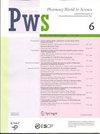ERYTHROCYTES AGGREGABILITY AND INTRACARDIAC HEMODYNAMICS IN PATIENTS WITH ATRIAL FIBRILLATION
引用次数: 0
Abstract
According to the World Health Organization the morbidity of atrial fibrillations is 1-2% of the general population, which is extremely high number due to the severity of the disease. The frequency of morbidity will increase by about 2.5 times (1). Namely, the unfavorable epidemiological picture of atrial fibrillation makes the project relevant. There are numerous studies, although intracardiac hemodynamics and hemorheologycal parameters and their role in the course of atrial fibrillation have not been studied; We have studied the hemorheological profile in patients with atrial fibrillation. Changes of rheological parameters and hemodynamics were assessed against the background of rhythm disturbances. We examined 50 patients (women-22, men - 28, the average age of 65±10) and 20 healthy volunteers. We have studied the Index of the Erythrocytes aggregability, which is the area of aggregated erythrocytes divided by the full area of the erythrocytes. These new innovative methods “Georgian Technique” is created by Georgian scientists and they are famous in the world as direct, numeral and exact [G. Mchedlishvili, 2004; N. Maeda, 2010; M. Mantskava M., 2011]. Also, all patients the studies: ECG, ECHOcardioscopy was performed. After statistical processing of the material, it was found that erythrocytes aggregability is highly impaired in patients with permanent and persistent forms of atrial fibrillation. Mean value of EAI is 41.7 ± 10.4 compared to the control group, where the average EAI value is within 25.6 ± 1.2. The Index of erythrocytes aggregability (EAI) are significantly increased in inverse proportion to the decrease of the left ventricular ejection fraction. A negative correlation was revealed between the Index of erythrocytes aggregation and the left ventricular ejection fraction (R=0.4); According to the obtained data, changes of rheological parameters deepen in the wake of disruption of intracardiac hemodynamics; This confirms the notion that a small blood vessel is the "target" in the case of atrial fibrillation. From hemodynamic mechanisms rheology plays an important role. They are determinants of hemodynamic processes in the body (2).心房颤动患者的红细胞聚集性和心内血流动力学
根据世界卫生组织的数据,房颤的发病率为总人口的1-2%,由于疾病的严重性,这是一个非常高的数字。发病频率将增加约2.5倍(1)。也就是说,心房颤动的不利流行病学情况使该项目具有相关性。有大量的研究,虽然心内血流动力学和血液流变学参数及其在房颤过程中的作用尚未研究;我们研究了房颤患者的血液流变学特征。在节律紊乱的背景下评估流变学参数和血流动力学的变化。我们检查了50例患者(女性22例,男性28例,平均年龄65±10岁)和20名健康志愿者。我们研究了红细胞聚集指数,它是红细胞聚集的面积除以红细胞的全部面积。这些新的创新方法“格鲁吉亚技术”是由格鲁吉亚科学家创造的,它们以直接、数字和精确而闻名于世。Mchedlishvili, 2004;N. Maeda, 2010;M. Mantskava, 2011]。同时,对所有患者进行心电图、超声心动图检查。在对资料进行统计处理后,发现永久性和持续性房颤患者的红细胞聚集性严重受损。对照组EAI平均值为41.7±10.4,对照组EAI平均值在25.6±1.2以内。红细胞聚集指数(EAI)与左室射血分数的降低成反比显著升高。红细胞聚集指数与左室射血分数呈负相关(R=0.4);根据所获得的数据,流变学参数的变化随着心内血流动力学的破坏而加深;这证实了小血管是心房颤动的“目标”。从血流动力学机制来看,流变学起着重要的作用。它们是体内血流动力学过程的决定因素(2)。
本文章由计算机程序翻译,如有差异,请以英文原文为准。
求助全文
约1分钟内获得全文
求助全文

 求助内容:
求助内容: 应助结果提醒方式:
应助结果提醒方式:


